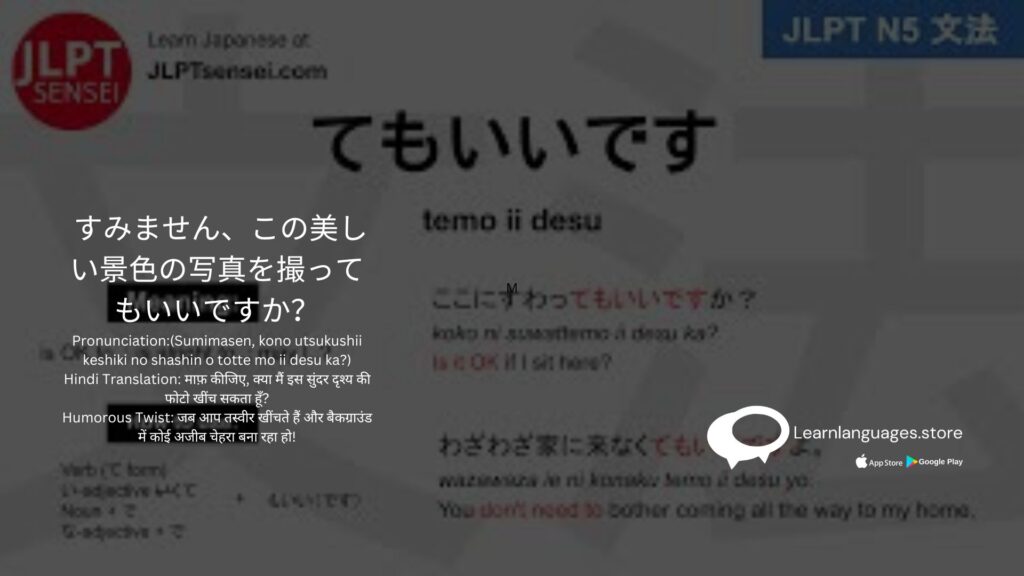Mastering „Äú„Ā¶„āā„ĀĄ„ĀĄ„Āß„Āô„Āč (temo ii desu ka) in Japanese Grammar: An Extensive Guide with Examples
Mastering „Äú„Ā¶„āā„ĀĄ„ĀĄ„Āß„Āô„Āč (temo ii desu ka) in Japanese Grammar: An Extensive Guide with Examples
Estimated reading time: 5 minutes

„Āď„āď„Āę„Ā°„ĀĮ (Kon’nichiwa)! Welcome to our Japanese language blog, where we break down complex grammar topics into fun and digestible pieces. Today, we will delve into the phrase „Äú„Ā¶„āā„ĀĄ„ĀĄ„Āß„Āô„Āč (temo ii desu ka), a polite and useful expression meaning “Is it okay if…?” or “May I…?” This phrase is essential for asking permission and making polite requests in Japanese. Let‚Äôs explore its usage, structure, and provide some humorous examples to make your learning experience enjoyable!
Understanding „Äú„Ā¶„āā„ĀĄ„ĀĄ„Āß„Āô„Āč (temo ii desu ka)
Sentence Structure
The structure of „Äú„Ā¶„āā„ĀĄ„ĀĄ„Āß„Āô„Āč (temo ii desu ka) is quite straightforward. Here‚Äôs how it works:
- Start with the „Ā¶ (te) form of a verb.
- Add „āā„ĀĄ„ĀĄ„Āß„Āô„Āč (mo ii desu ka) to the end.
Examples with Different Verbs
- Verb: ť£ü„ĀĻ„āč („Āü„ĀĻ„āč, taberu) – to eat
- „Ā¶ form: ť£ü„ĀĻ„Ā¶ („Āü„ĀĻ„Ā¶, tabete)
- Combined: ť£ü„ĀĻ„Ā¶„āā„ĀĄ„ĀĄ„Āß„Āô„Āč („Āü„ĀĻ„Ā¶„āā„ĀĄ„ĀĄ„Āß„Āô„Āč, tabete mo ii desu ka) – Is it okay if I eat? / May I eat?
- Verb: Ť°Ć„ĀŹ („ĀĄ„ĀŹ, iku) – to go
- „Ā¶ form: Ť°Ć„Ā£„Ā¶ („ĀĄ„Ā£„Ā¶, itte)
- Combined: Ť°Ć„Ā£„Ā¶„āā„ĀĄ„ĀĄ„Āß„Āô„Āč („ĀĄ„Ā£„Ā¶„āā„ĀĄ„ĀĄ„Āß„Āô„Āč, itte mo ii desu ka) – Is it okay if I go? / May I go?
- Verb: Ť¶č„āč („ĀŅ„āč, miru) – to watch/see
- „Ā¶ form: Ť¶č„Ā¶ („ĀŅ„Ā¶, mite)
- Combined: Ť¶č„Ā¶„āā„ĀĄ„ĀĄ„Āß„Āô„Āč („ĀŅ„Ā¶„āā„ĀĄ„ĀĄ„Āß„Āô„Āč, mite mo ii desu ka) – Is it okay if I watch? / May I watch?
Pronunciation Guide Using Hindi Alphabets
- ť£ü„ĀĻ„Ā¶„āā„ĀĄ„ĀĄ„Āß„Āô„Āč (tabete mo ii desu ka) – ŗ§§ŗ§ĺŗ§¨ŗ•áŗ§§ŗ•á ŗ§ģŗ•č ŗ§ąŗ§á ŗ§¶ŗ•áŗ§łŗ•Ā ŗ§ēŗ§ĺ
- Ť°Ć„Ā£„Ā¶„āā„ĀĄ„ĀĄ„Āß„Āô„Āč (itte mo ii desu ka) – ŗ§áŗ§§ŗ•ćŗ§§ŗ•á ŗ§ģŗ•č ŗ§ąŗ§á ŗ§¶ŗ•áŗ§łŗ•Ā ŗ§ēŗ§ĺ
- Ť¶č„Ā¶„āā„ĀĄ„ĀĄ„Āß„Āô„Āč (mite mo ii desu ka) – ŗ§ģŗ•Äŗ§§ŗ•á ŗ§ģŗ•č ŗ§ąŗ§á ŗ§¶ŗ•áŗ§łŗ•Ā ŗ§ēŗ§ĺ
Example Sentences with Humor
- ť£ü„ĀĻ„Ā¶„āā„ĀĄ„ĀĄ„Āß„Āô„Āč („Āü„ĀĻ„Ā¶„āā„ĀĄ„ĀĄ„Āß„Āô„Āč, tabete mo ii desu ka) – May I eat?
- Example: „Āď„Āģ„āĪ„Éľ„ā≠„ÄĀÁĺéŚĎ≥„Āó„ĀĚ„ĀÜ„Ā†„Āč„āČť£ü„ĀĻ„Ā¶„āā„ĀĄ„ĀĄ„Āß„Āô„ĀčÔľü
- Pronunciation: „Āď„Āģ„āĪ„Éľ„ā≠„ÄĀ„Āä„ĀĄ„Āó„ĀĚ„ĀÜ„Ā†„Āč„āČ„Āü„ĀĻ„Ā¶„āā„ĀĄ„ĀĄ„Āß„Āô„ĀčÔľü (Kono keeki, oishisou dakara tabete mo ii desu ka?)
- Hindi Translation: ŗ§Įŗ§Ļ ŗ§ēŗ•áŗ§ē ŗ§łŗ•ćŗ§Ķŗ§ĺŗ§¶ŗ§Ņŗ§∑ŗ•ćŗ§ü ŗ§≤ŗ§ó ŗ§įŗ§Ļŗ§ĺ ŗ§Ļŗ•ą, ŗ§ēŗ•ćŗ§Įŗ§ĺ ŗ§ģŗ•ąŗ§ā ŗ§áŗ§łŗ•á ŗ§Ėŗ§ĺ ŗ§łŗ§ēŗ§§ŗ§ĺ ŗ§Ļŗ•āŗ§Ā?
- Humorous Twist: ŗ§úŗ§¨ ŗ§Üŗ§™ ŗ§Öŗ§™ŗ§®ŗ•á ŗ§¶ŗ•čŗ§łŗ•ćŗ§§ ŗ§ēŗ•Ä ŗ§™ŗ•ćŗ§≤ŗ•áŗ§ü ŗ§łŗ•á ŗ§¨ŗ§Ņŗ§®ŗ§ĺ ŗ§™ŗ•āŗ§õŗ•á ŗ§Ėŗ§ĺŗ§®ŗ•á ŗ§ēŗ•á ŗ§≤ŗ§Ņŗ§Ź ŗ§Įŗ§Ļ ŗ§łŗ§Ķŗ§ĺŗ§≤ ŗ§™ŗ•āŗ§õŗ§§ŗ•á ŗ§Ļŗ•ąŗ§ā!
- Ť°Ć„Ā£„Ā¶„āā„ĀĄ„ĀĄ„Āß„Āô„Āč („ĀĄ„Ā£„Ā¶„āā„ĀĄ„ĀĄ„Āß„Āô„Āč, itte mo ii desu ka) – May I go?
- Example: śėéśó•„ĀĮŚŹčťĀĒ„Ā®śė†ÁĒĽ„ĀꍰƄĀ£„Ā¶„āā„ĀĄ„ĀĄ„Āß„Āô„ĀčÔľü
- Pronunciation: „Āā„Āó„Āü„ĀĮ„Ā®„āā„Ā†„Ā°„Ā®„Āą„ĀĄ„ĀĆ„Āę„ĀĄ„Ā£„Ā¶„āā„ĀĄ„ĀĄ„Āß„Āô„ĀčÔľü (Ashita wa tomodachi to eiga ni itte mo ii desu ka?)
- Hindi Translation: ŗ§ēŗ•ćŗ§Įŗ§ĺ ŗ§ģŗ•ąŗ§ā ŗ§ēŗ§≤ ŗ§Öŗ§™ŗ§®ŗ•á ŗ§¶ŗ•čŗ§łŗ•ćŗ§§ ŗ§ēŗ•á ŗ§łŗ§ĺŗ§• ŗ§ęŗ§Ņŗ§≤ŗ•ćŗ§ģ ŗ§¶ŗ•áŗ§Ėŗ§®ŗ•á ŗ§úŗ§ĺ ŗ§łŗ§ēŗ§§ŗ§ĺ ŗ§Ļŗ•āŗ§Ā?
- Humorous Twist: ŗ§úŗ§¨ ŗ§Üŗ§™ ŗ§Įŗ§Ļ ŗ§łŗ§Ķŗ§ĺŗ§≤ ŗ§™ŗ•āŗ§õŗ§§ŗ•á ŗ§Ļŗ•ąŗ§ā ŗ§Ēŗ§į ŗ§Üŗ§™ŗ§ēŗ§ĺ ŗ§¶ŗ•čŗ§łŗ•ćŗ§§ ŗ§ēŗ§Ļŗ§§ŗ§ĺ ŗ§Ļŗ•ą, “ŗ§Ļŗ§ĺŗ§Ā, ŗ§≤ŗ•áŗ§ēŗ§Ņŗ§® ŗ§§ŗ•Āŗ§ģ ŗ§™ŗ•Čŗ§™ŗ§ēŗ•Čŗ§įŗ•ćŗ§® ŗ§≤ŗ§ĺŗ§®ŗ§ĺ ŗ§ģŗ§§ ŗ§≠ŗ•āŗ§≤ŗ§®ŗ§ĺ!”
- Ť¶č„Ā¶„āā„ĀĄ„ĀĄ„Āß„Āô„Āč („ĀŅ„Ā¶„āā„ĀĄ„ĀĄ„Āß„Āô„Āč, mite mo ii desu ka) – May I watch?
- Example: „Āā„Ā™„Āü„ĀģśĖį„Āó„ĀĄ„āĘ„Éč„É°„ā≥„ɨ„āĮ„ā∑„Éß„É≥„ā퍶č„Ā¶„āā„ĀĄ„ĀĄ„Āß„Āô„ĀčÔľü
- Pronunciation: „Āā„Ā™„Āü„Āģ„Āā„Āü„āČ„Āó„ĀĄ„āĘ„Éč„É°„ā≥„ɨ„āĮ„ā∑„Éß„É≥„āí„ĀŅ„Ā¶„āā„ĀĄ„ĀĄ„Āß„Āô„ĀčÔľü (Anata no atarashii anime korekushon o mite mo ii desu ka?)
- Hindi Translation: ŗ§ēŗ•ćŗ§Įŗ§ĺ ŗ§ģŗ•ąŗ§ā ŗ§Üŗ§™ŗ§ēŗ•Ä ŗ§®ŗ§ą ŗ§Źŗ§®ŗ•Äŗ§ģŗ•á ŗ§ēŗ§≤ŗ•áŗ§ēŗ•ćŗ§∂ŗ§® ŗ§¶ŗ•áŗ§Ė ŗ§łŗ§ēŗ§§ŗ§ĺ ŗ§Ļŗ•āŗ§Ā?
- Humorous Twist: ŗ§úŗ§¨ ŗ§Üŗ§™ ŗ§¶ŗ•áŗ§Ėŗ§§ŗ•á ŗ§Ļŗ•ąŗ§ā ŗ§ēŗ§Ņ ŗ§Üŗ§™ŗ§ēŗ•Ä ŗ§¶ŗ•čŗ§łŗ•ćŗ§§ ŗ§ēŗ•Ä ŗ§Źŗ§®ŗ•Äŗ§ģŗ•á ŗ§ēŗ§≤ŗ•áŗ§ēŗ•ćŗ§∂ŗ§® ŗ§ģŗ•áŗ§ā ŗ§ēŗ•Āŗ§õ ŗ§Öŗ§úŗ•Äŗ§¨ ŗ§Źŗ§®ŗ•Äŗ§ģŗ•á ŗ§≠ŗ•Ä ŗ§∂ŗ§ĺŗ§ģŗ§Ņŗ§≤ ŗ§Ļŗ•ąŗ§ā!
Usage and Exceptions
General Usage
The phrase „Äú„Ā¶„āā„ĀĄ„ĀĄ„Āß„Āô„Āč (temo ii desu ka) is used to politely ask for permission to do something. It can be used in both formal and casual contexts, making it a versatile phrase for various situations.
Exceptions
While „Äú„Ā¶„āā„ĀĄ„ĀĄ„Āß„Āô„Āč (temo ii desu ka) is generally polite, it might not be suitable for very formal requests or official situations where more formal language is required. In such cases, you might use „Äú„Ā¶„āā„āą„āć„Āó„ĀĄ„Āß„Āô„Āč (temo yoroshii desu ka), which is a more formal version.
More Examples for Clarity
- ŚÜôÁúü„āíśíģ„Ā£„Ā¶„āā„ĀĄ„ĀĄ„Āß„Āô„Āč („Āó„āÉ„Āó„āď„āí„Ā®„Ā£„Ā¶„āā„ĀĄ„ĀĄ„Āß„Āô„Āč, shashin o totte mo ii desu ka) – May I take a picture?
- Example: „Āô„ĀŅ„Āĺ„Āõ„āď„ÄĀ„Āď„ĀģÁĺé„Āó„ĀĄśôĮŤČ≤„ĀģŚÜôÁúü„āíśíģ„Ā£„Ā¶„āā„ĀĄ„ĀĄ„Āß„Āô„ĀčÔľü
- Pronunciation: „Āô„ĀŅ„Āĺ„Āõ„āď„ÄĀ„Āď„Āģ„ĀÜ„Ā§„ĀŹ„Āó„ĀĄ„ĀĎ„Āó„Āć„Āģ„Āó„āÉ„Āó„āď„āí„Ā®„Ā£„Ā¶„āā„ĀĄ„ĀĄ„Āß„Āô„ĀčÔľü (Sumimasen, kono utsukushii keshiki no shashin o totte mo ii desu ka?)
- Hindi Translation: ŗ§ģŗ§ĺŗ§ęŗ§ľ ŗ§ēŗ•Äŗ§úŗ§Ņŗ§Ź, ŗ§ēŗ•ćŗ§Įŗ§ĺ ŗ§ģŗ•ąŗ§ā ŗ§áŗ§ł ŗ§łŗ•Āŗ§āŗ§¶ŗ§į ŗ§¶ŗ•Éŗ§∂ŗ•ćŗ§Į ŗ§ēŗ•Ä ŗ§ęŗ•čŗ§üŗ•č ŗ§Ėŗ•Äŗ§āŗ§ö ŗ§łŗ§ēŗ§§ŗ§ĺ ŗ§Ļŗ•āŗ§Ā?
- Humorous Twist: ŗ§úŗ§¨ ŗ§Üŗ§™ ŗ§§ŗ§łŗ•ćŗ§Ķŗ•Äŗ§į ŗ§Ėŗ•Äŗ§āŗ§öŗ§§ŗ•á ŗ§Ļŗ•ąŗ§ā ŗ§Ēŗ§į ŗ§¨ŗ•ąŗ§ēŗ§óŗ•ćŗ§įŗ§ĺŗ§Čŗ§āŗ§° ŗ§ģŗ•áŗ§ā ŗ§ēŗ•čŗ§ą ŗ§Öŗ§úŗ•Äŗ§¨ ŗ§öŗ•áŗ§Ļŗ§įŗ§ĺ ŗ§¨ŗ§®ŗ§ĺ ŗ§įŗ§Ļŗ§ĺ ŗ§Ļŗ•č!
- „Āď„Āď„ĀęŚļß„Ā£„Ā¶„āā„ĀĄ„ĀĄ„Āß„Āô„Āč („Āď„Āď„Āę„Āô„āŹ„Ā£„Ā¶„āā„ĀĄ„ĀĄ„Āß„Āô„Āč, koko ni suwatte mo ii desu ka) – May I sit here?
- Example: „Āô„ĀŅ„Āĺ„Āõ„āď„ÄĀ„Āď„ĀģŚł≠„ĀęŚļß„Ā£„Ā¶„āā„ĀĄ„ĀĄ„Āß„Āô„ĀčÔľü
- Pronunciation: „Āô„ĀŅ„Āĺ„Āõ„āď„ÄĀ„Āď„Āģ„Āõ„Āć„Āę„Āô„āŹ„Ā£„Ā¶„āā„ĀĄ„ĀĄ„Āß„Āô„ĀčÔľü (Sumimasen, kono seki ni suwatte mo ii desu ka?)
- Hindi Translation: ŗ§ģŗ§ĺŗ§ęŗ§ľ ŗ§ēŗ•Äŗ§úŗ§Ņŗ§Ź, ŗ§ēŗ•ćŗ§Įŗ§ĺ ŗ§ģŗ•ąŗ§ā ŗ§áŗ§ł ŗ§łŗ•Äŗ§ü ŗ§™ŗ§į ŗ§¨ŗ•ąŗ§† ŗ§łŗ§ēŗ§§ŗ§ĺ ŗ§Ļŗ•āŗ§Ā?
- Humorous Twist: ŗ§úŗ§¨ ŗ§Üŗ§™ ŗ§™ŗ•āŗ§õŗ§§ŗ•á ŗ§Ļŗ•ąŗ§ā ŗ§Ēŗ§į ŗ§™ŗ§§ŗ§ĺ ŗ§öŗ§≤ŗ§§ŗ§ĺ ŗ§Ļŗ•ą ŗ§ēŗ§Ņ ŗ§Ķŗ§Ļ ŗ§łŗ•Äŗ§ü ŗ§üŗ•āŗ§ü ŗ§öŗ•Āŗ§ēŗ•Ä ŗ§Ļŗ•ą!
- šĹŅ„Ā£„Ā¶„āā„ĀĄ„ĀĄ„Āß„Āô„Āč („Ā§„Āč„Ā£„Ā¶„āā„ĀĄ„ĀĄ„Āß„Āô„Āč, tsukatte mo ii desu ka) – May I use?
- Example: „Āā„Ā™„Āü„Āģ„Éö„É≥„āíšĹŅ„Ā£„Ā¶„āā„ĀĄ„ĀĄ„Āß„Āô„ĀčÔľü
- Pronunciation: „Āā„Ā™„Āü„Āģ„Āļ„āď„āí„Ā§„Āč„Ā£„Ā¶„āā„ĀĄ„ĀĄ„Āß„Āô„ĀčÔľü (Anata no pen o tsukatte mo ii desu ka?)
- Hindi Translation: ŗ§ēŗ•ćŗ§Įŗ§ĺ ŗ§ģŗ•ąŗ§ā ŗ§Üŗ§™ŗ§ēŗ§ĺ ŗ§™ŗ•áŗ§® ŗ§áŗ§łŗ•ćŗ§§ŗ•áŗ§ģŗ§ĺŗ§≤ ŗ§ēŗ§į ŗ§łŗ§ēŗ§§ŗ§ĺ ŗ§Ļŗ•āŗ§Ā?
- Humorous Twist: ŗ§úŗ§¨ ŗ§Üŗ§™ ŗ§™ŗ•áŗ§® ŗ§ģŗ§ĺŗ§āŗ§óŗ§§ŗ•á ŗ§Ļŗ•ąŗ§ā ŗ§Ēŗ§į ŗ§Üŗ§™ŗ§ēŗ§ĺ ŗ§¶ŗ•čŗ§łŗ•ćŗ§§ ŗ§ēŗ§Ļŗ§§ŗ§ĺ ŗ§Ļŗ•ą, “ŗ§Ļŗ§ĺŗ§Ā, ŗ§≤ŗ•áŗ§ēŗ§Ņŗ§® ŗ§Įŗ§Ļ ŗ§™ŗ•áŗ§® ŗ§łŗ•ćŗ§Įŗ§ĺŗ§Ļŗ•Ä ŗ§®ŗ§Ļŗ•Äŗ§ā ŗ§Ļŗ•ą!”
Conclusion
In conclusion, mastering „Äú„Ā¶„āā„ĀĄ„ĀĄ„Āß„Āô„Āč (temo ii desu ka) is essential for asking permission and making polite requests in Japanese. This phrase is widely used in everyday conversations and helps you communicate more effectively and politely. Practice using it with different verbs to become comfortable with the structure. Remember to have fun with our humorous examples, which will make your learning journey enjoyable!
Happy learning! „Āĺ„Āü„Ā≠ (Matane)!
-
Product on sale
 Japanese N4
Japanese N4₹18,300.00
₹24,300.00 -
Product on sale
 Japanese N5
Japanese N5₹16,300.00
₹18,300.00
Learn Languages Store
Vashi,
Email: services@learnlanguages.store










